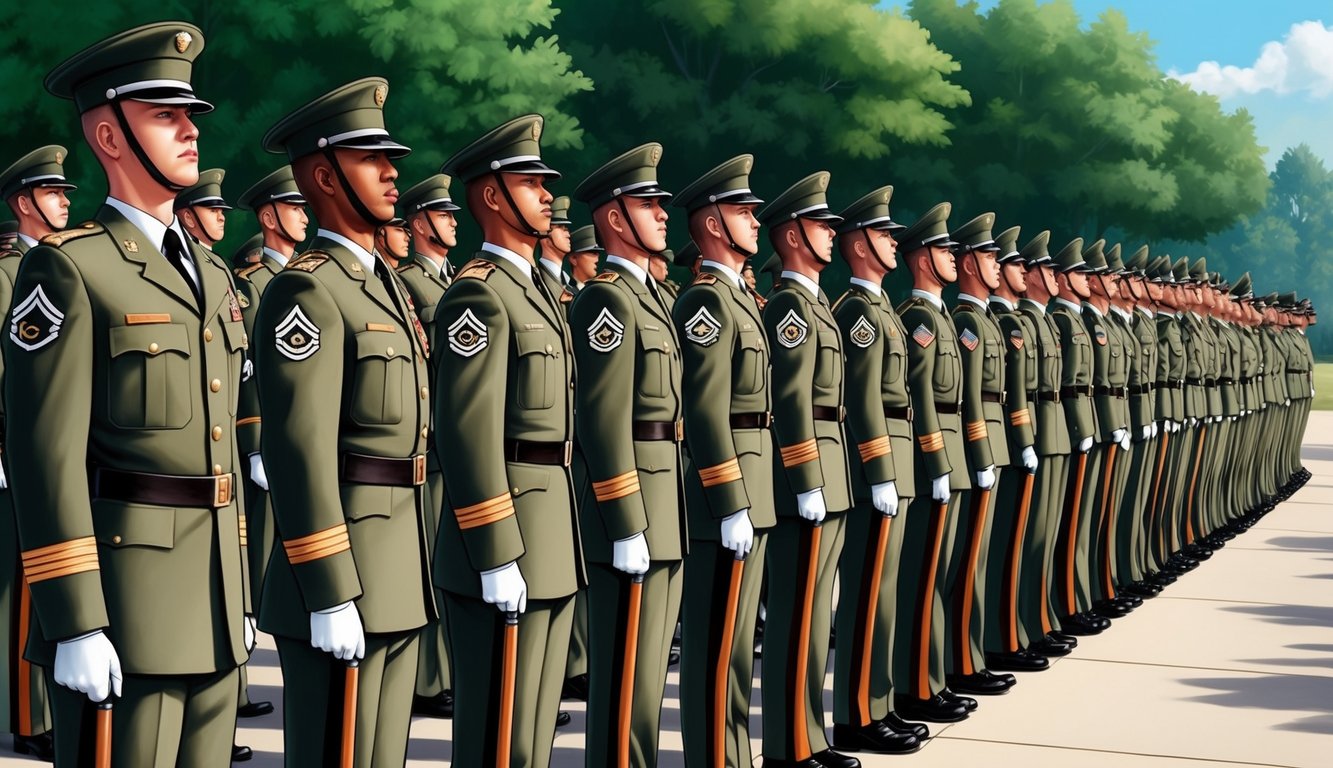“`xml
The National Guard occupies a distinct role within the U.S. military framework, tasked with both state and federal missions.
As a National Guard member, you’ll navigate a rank system that closely resembles that of active-duty Army and Air Force personnel. These ranks are indicative not only of your pay grade but also of your responsibilities and leadership roles within the organization.
Familiarizing yourself with the National Guard rank structure is crucial for anyone contemplating enlistment or currently serving.
From Private to General, each rank entails specific duties and expectations.
Advancement through the ranks demands commitment, skill development, and duration of service.
The National Guard provides paths for both enlisted individuals and officers, each offering unique challenges and rewards.
Whether you’re seeking a part-time role or aiming for a full-time career, understanding the rank structure will aid you in navigating your military path and establishing attainable advancement goals.
Key Takeaways
- National Guard ranks mirror those of the active-duty Army and Air Force
- Advancement necessitates dedication, skill growth, and service time
- The Guard offers career opportunities for enlisted members and officers
History of the National Guard
The origins of the National Guard date back to colonial America, evolving from local militias into a vital part of the U.S. military.
Its storied history includes extensive service in both domestic and international conflicts.
Early Formation and Key Battles
You may find it interesting that the National Guard’s beginnings can be traced to 1636 in Massachusetts, where colonial militia were established to defend settlers from Native American assaults.
These citizen-soldiers played a crucial role during the American Revolution, notably at Lexington and Concord.
In the Civil War, state militias became increasingly organized, contributing to both sides of the conflict and demonstrating their significance in national defense.
The National Guard saw its first overseas deployments in World War I, contributing 40% of the American Expeditionary Forces in France.
The National Guard in Recent Times
In World War II, the Guard reaffirmed its value, with over 300,000 members serving and entire divisions deployed to both the European and Pacific theaters.
After the war, the Guard’s responsibilities grew.
You may recognize them from their responses to natural disasters or civil unrest in your locality, assisting during hurricanes, floods, and even the COVID-19 pandemic.
Additionally, Guard units have been deployed overseas to Iraq and Afghanistan, participating in peacekeeping missions and humanitarian efforts globally.
Today’s National Guard is equipped with modern technology and specialized training programs.
It maintains a balance between its dual state and federal missions, ready to respond both at home and abroad.
National Guard Structure
The National Guard has a distinctive structure that integrates state and federal responsibilities.
Operating across the U.S. and its territories, the Guard collaborates with various government agencies to carry out a range of missions.
Distinguishing Army and Air National Guard
The National Guard comprises two primary branches: the Army National Guard and the Air National Guard.
Each branch possesses its unique command structure and areas of specialization.
The Army National Guard is geared toward ground operations, whereas the Air National Guard excels in air support and aerospace missions.
Both branches share a similar rank framework that reflects their active-duty counterparts.
However, the dual state-federal function of the National Guard differentiates it, as members can be summoned for state duties by their governor or federal duties by the President.
Geographic Distribution
National Guard units are established across all 50 states, the District of Columbia, and U.S. territories.
This extensive distribution enables a swift response to local emergencies and national crises.
Each state and territory’s Guard forces are tailored to meet specific needs.
For instance, coastal areas may host naval-focused units, while mountainous regions might prioritize alpine rescue capabilities.
This geographical presence ensures that National Guard resources are readily accessible, poised to respond during natural disasters, civil disturbances, or other crises.
Alignment with Federal and State Agencies
The National Guard’s unique status facilitates seamless collaboration with both state and federal agencies.
At the local level, Guard units often work alongside law enforcement, fire departments, and emergency services.
Federally, the National Guard Bureau partners with the U.S. Army, Air Force, and Department of Homeland Security, which is vital for national defense and large-scale disaster response.
During emergencies, you might see Guard personnel supporting FEMA or other federal agencies.
This adaptability enables the National Guard to connect local, state, and federal response efforts, providing a cohesive and effective approach to various challenges.
Enlisted Ranks and Insignia
The National Guard adopts the same enlisted rank system as the Army.
These ranks are classified into junior enlisted soldiers and non-commissioned officers (NCOs), each with unique responsibilities and insignia.
Junior Enlisted Ranks
As a new recruit, your journey begins as a Private (PV1), a rank that bears no insignia.
In a few months, progression to Private (PV2) will likely see you earn a single chevron on your uniform.
The next rank is Private First Class (PFC), marked by a single chevron and a rocker.
Alternatively, you may attain the Specialist (SPC) rank, equivalent to Corporal, both classified at pay grade E-4.
Specialists are recognized by a patch depicting an eagle within a chevron.
Non-Commissioned Officer (NCO) Ranks
NCOs serve as the backbone of the National Guard.
Corporals and Sergeants, both at E-4, wear two chevrons.
Staff Sergeants are recognized with three chevrons, while Sergeant First Class is denoted with three chevrons and two rockers.
The ranks of Master Sergeant and First Sergeant are both classified as E-8, with minor distinctions in their insignia.
The pinnacle enlisted rank is Sergeant Major of the Army, identifiable by three chevrons, three rockers, and a star.
NCO ranks feature gold stripes against a dark backdrop, with some positions possibly including silver specialty rating marks indicating specific earned skills or qualifications.
Officer Ranks and Career Progression
The officer ranks within the National Guard are organized from company grade to general officers, with each rank associated with greater responsibilities and leadership opportunities.
Promotions are contingent on factors such as service duration, performance evaluations, and professional growth.
Company Grade Officers
As a newly commissioned Second Lieutenant, you will lead a platoon of 30-40 soldiers.
As you gain experience, you’ll advance to First Lieutenant, tackling more complex leadership responsibilities.
Captains oversee companies of 100-200 soldiers and may serve as staff officers at the battalion level.
Your key responsibilities will include:
- Directing day-to-day operations
- Training and mentoring junior enlisted soldiers
- Developing tactical plans
- Managing resources and equipment
Advancement to Captain typically occurs after serving four years as a Lieutenant, during which you must complete the Officer Basic Course and Captain’s Career Course.
Field Grade Officers
Field grade officers begin at the rank of Major, likely serving as a battalion executive officer or operations officer.
Lieutenant Colonels typically command battalions or serve on brigade staff, while Colonels lead brigades or occupy senior staff roles at the division level.
Career milestones include:
- Major: 10-12 years of service
- Lieutenant Colonel: 16-18 years
- Colonel: 22+ years
A successful career path will involve achieving professional military education through institutions like the Command and General Staff College.
Competitive selection boards will assess your performance and potential for higher command.
General Officers
Ascension to general officer ranks is highly competitive.
As a Brigadier General (one-star), you might command a brigade or serve as a division’s deputy commander.
Major Generals (two-star) usually lead divisions or significant commands.
The highest ranks include:
- Lieutenant General (three-star)
- General (four-star)
Occupying these positions involves strategic planning, policy formulation, and engagement with civilian leadership.
Only a select few officers achieve general officer status, generally after 25-30 years of distinguished service.
Warrant Officer Corps
The Warrant Officer Corps serves as a bridge between enlisted service members and commissioned officers.
These technical specialists provide unique skills and leadership across various disciplines.
Warrant Officer Ranks
The entry-level rank is Warrant Officer 1 (WO1), which you will achieve following completion of Warrant Officer Candidate School.
Next is Chief Warrant Officer 2 (CW2), where you will function as an intermediate technical and tactical expert.
As a Chief Warrant Officer 3 (CW3), you will become an advanced-level expert, supporting operations at different levels and mentoring junior warrant officers.
Moving to Chief Warrant Officer 4 (CW4), you will serve as a senior-level technical and tactical expert, often in staff positions, providing valuable insights to commanders.
Finally, Chief Warrant Officer 5 (CW5) represents the highest rank within the warrant officer tier.
In this role, you will be a master-level expert in your field, frequently advising senior leaders.
To advance, you will attend the Warrant Officer Career College for further training and leadership development.
National Guard Training and Duties
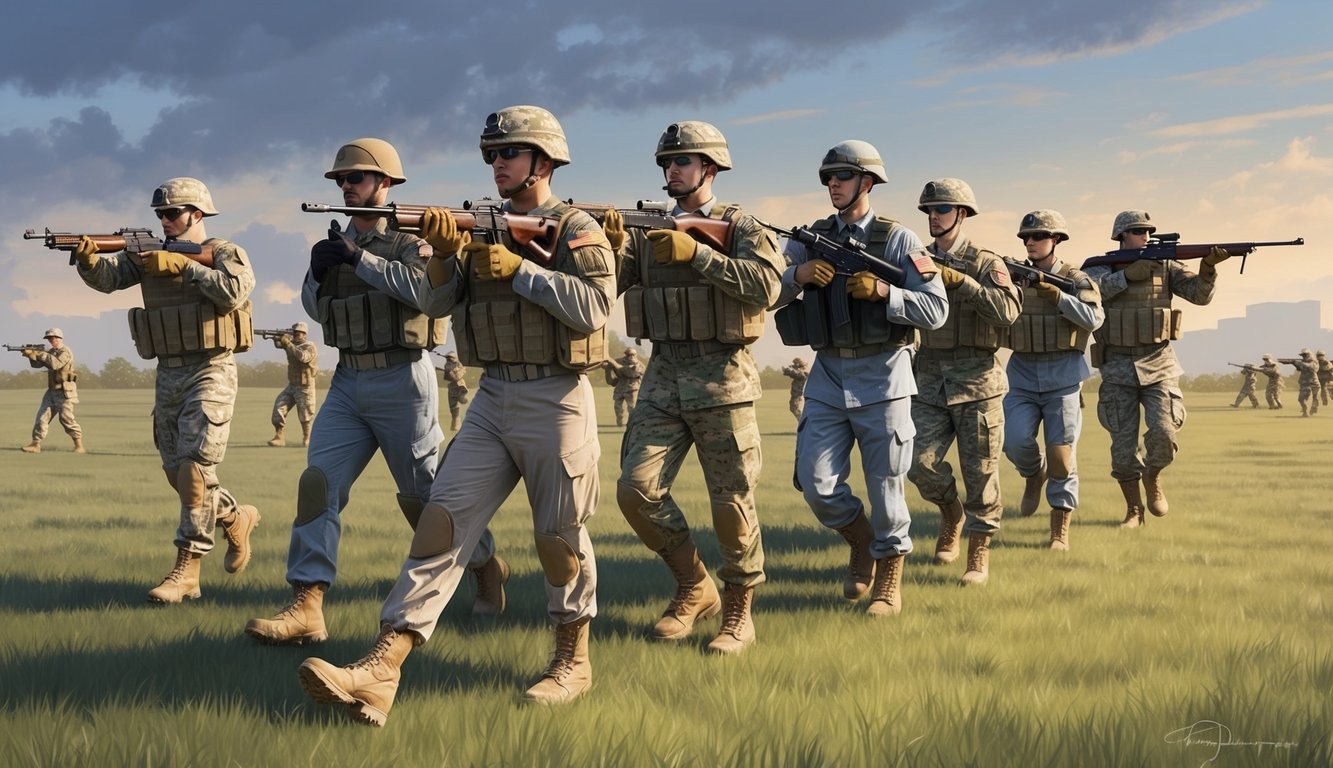
Members of the National Guard undergo extensive training and fulfill a variety of responsibilities to serve both their states and the nation.
As a Guard member, you will experience a blend of military readiness and community service.
Individual Training and Development
Your National Guard journey commences with Basic Training, an intensive 10-week course designed to mold you into a soldier.
You will acquire essential military skills, physical fitness, and discipline.
Following Basic Training, you’ll undergo Advanced Individual Training to gain proficiency in your specific Military Occupational Specialty.
Throughout your career, you will participate in regular weekend drills and annual training exercises, which are crucial for maintaining skills and unit preparedness.
Further, you will have opportunities to enroll in Professional Military Education courses to enhance your leadership skills and military acumen.
Specialized training is also provided by the Guard.
Depending on your unit’s requirements and your career objectives, you may train in areas such as airborne operations, combat medical skills, or cyber warfare.
Operational Deployments and State Missions
As a Guard member, you will be prepared to respond to both state emergencies and national security needs.
During natural disasters like floods or wildfires, you might be called upon to assist with evacuations, supply distributions, or medical aid to impacted communities.
Your state’s governor can activate you for various domestic support missions, which may include:
- Assisting law enforcement during civil disturbances
- Supporting border security operations
- Contributing to COVID-19 response initiatives
On a national level, you may deploy overseas for combat missions, peacekeeping efforts, or humanitarian assistance, typically for a duration of 9-12 months in various locations where U.S. forces are needed.
Branches and Specialty Commands
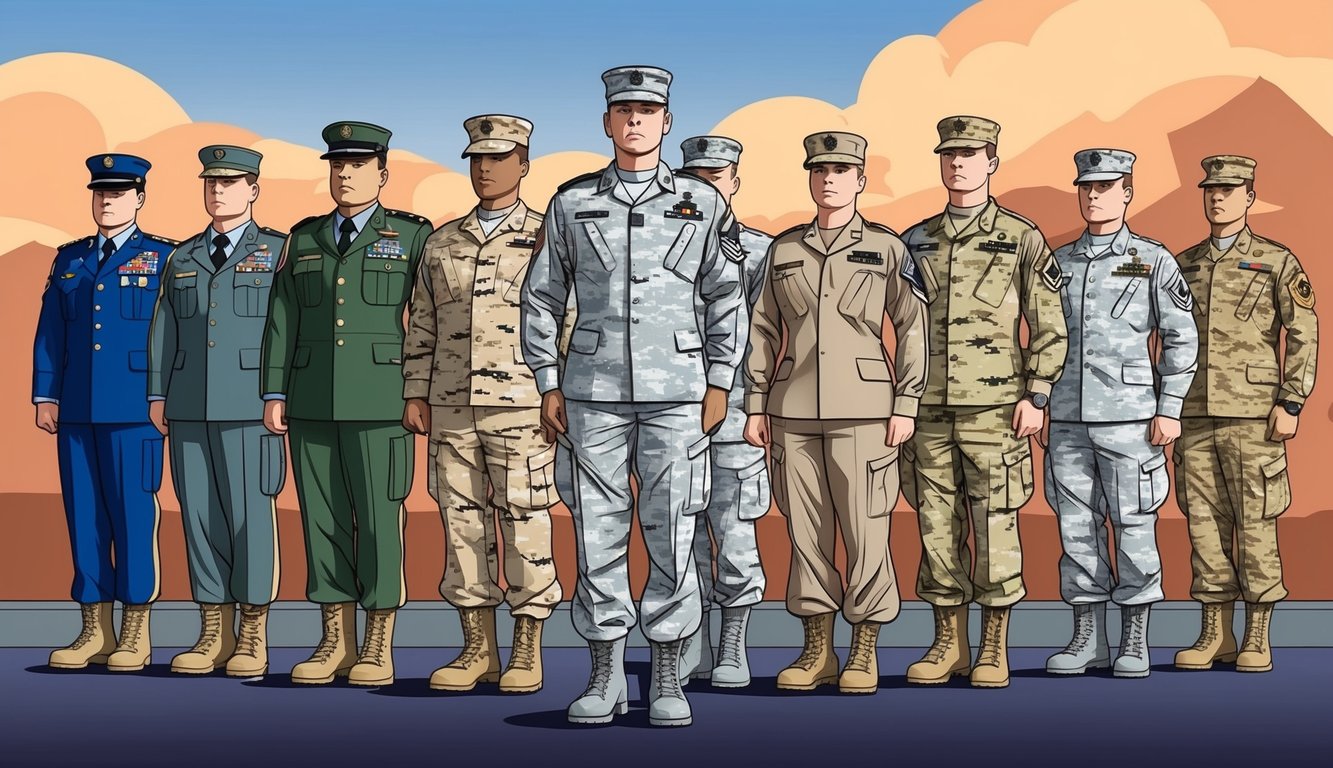
The National Guard’s framework includes a variety of components and specialized units across both the Army and Air branches.
These units fulfill specific roles and missions to support state and federal requirements.
Army National Guard Components
The Army National Guard comprises various specialized units.
Infantry and armor units serve as the foundation of ground forces, while aviation elements provide essential air support and transportation.
Cyber units focus on defending against digital threats.
As a Guard member, you might be part of a functional command such as intelligence or logistics, supporting broader operations across the force.
You could be a team leader in a small, specialized unit or oversee a larger platoon.
Units typically consist of squads of 9-10 soldiers, led by a sergeant.
These squads form the core of larger formations, and your role may involve coordination with other squads to achieve mission objectives.
Air National Guard Wings and Squadrons
In the Air National Guard, you’ll most likely be assigned to a wing or squadron structure.
Fighter wings house combat aircraft and pilots, while reconnaissance units collect vital intelligence using specialized aircraft and sensors.
Airlift squadrons play a critical role in transporting personnel and equipment, often operating large cargo aircraft.
As an Air Guard member, you could fulfill various functions within these units, covering areas from aircraft maintenance to mission planning.
Your specific duties will depend on your skills and the needs of your unit.
Role in Homeland Security and Emergency Response
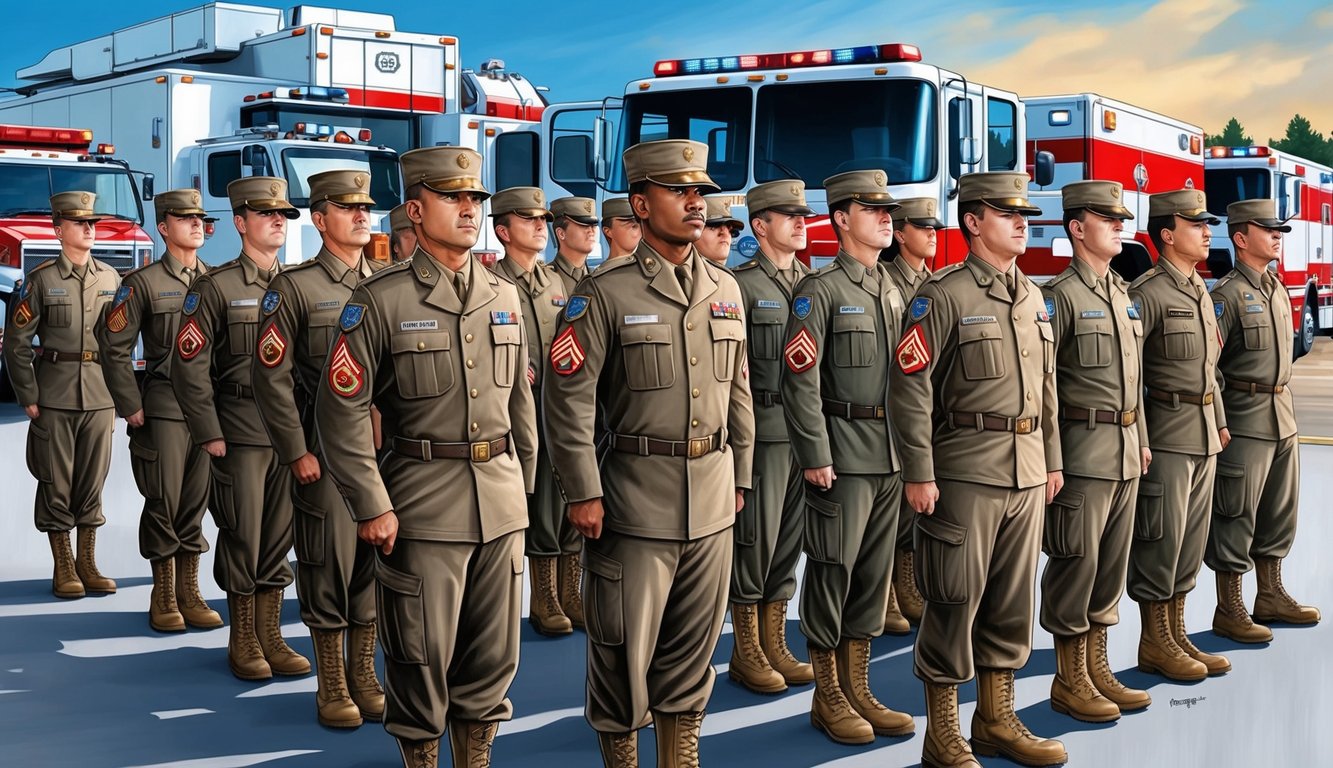
The National Guard plays an essential role in safeguarding communities and responding to crises across the United States.
Members are often at the forefront of disaster relief operations and emergency preparedness initiatives nationwide.
Coordination with Civil Authorities
During disasters, the National Guard collaborates closely with local first responders.
Guard units deploy rapidly to assist in evacuations, search and rescue efforts, and medical aid during events such as hurricanes, floods, and wildfires.
You will observe Guard personnel operating specialized equipment like helicopters and high-water vehicles to reach remote areas.
They also establish emergency shelters and distribute food, water, and supplies to affected communities.
In addition to responding to natural disasters, the Guard contributes to homeland security through its Civil Support Teams, trained to respond to incidents involving chemical, biological, and radiological threats.
This ensures local authorities can detect and manage hazardous materials effectively.
The Guard’s State Partnership Program fosters collaboration with partner nations, enhancing emergency preparedness both domestically and internationally.
This unique capability improves crisis management skills through knowledge sharing and joint training exercises.
Common Questions and Concerns
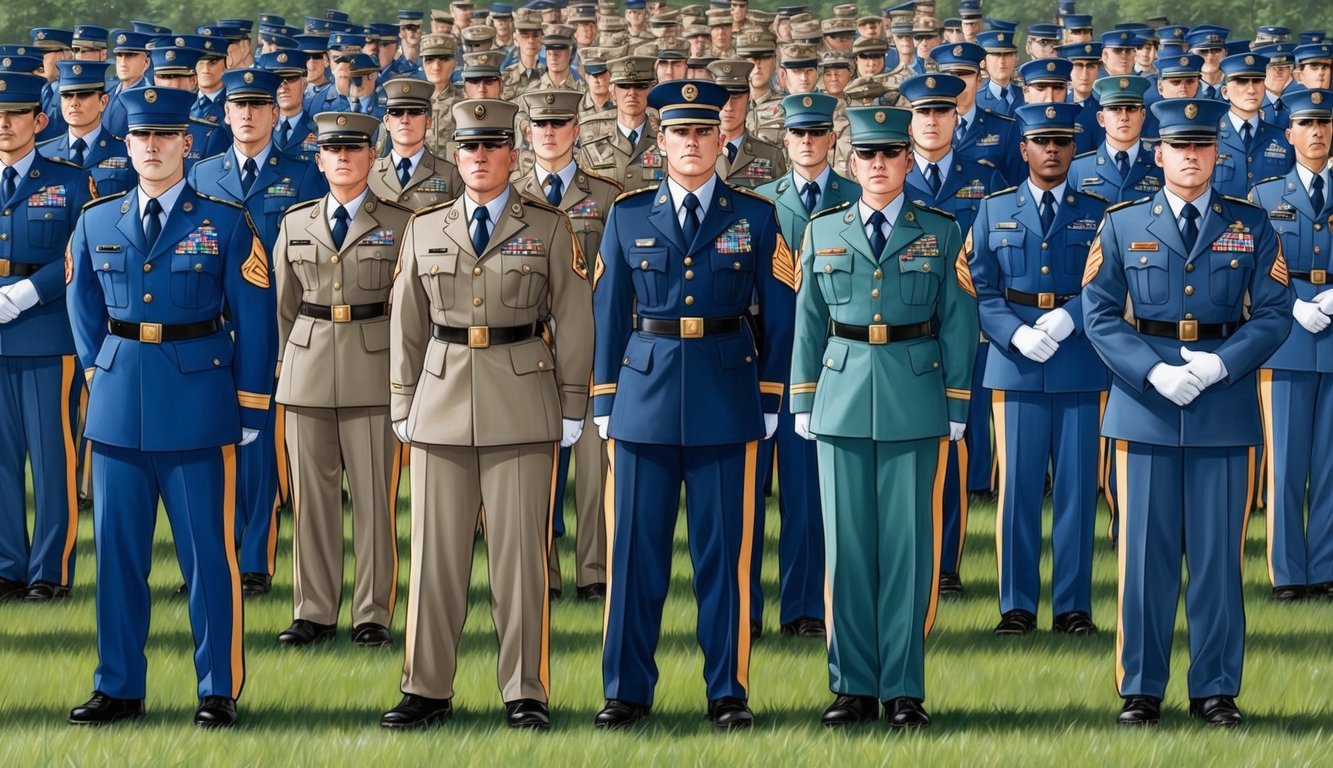
If you’re considering joining the National Guard, you might have some questions.
Let’s address a few frequently asked ones.
What are the eligibility requirements for enlistment? You should be between 17-35 years old, a U.S. citizen or permanent resident, and possess a high school diploma or equivalent.
A clean criminal record and good physical fitness are also essential.
What benefits does the Guard offer? Members are entitled to health insurance, retirement plans, and tuition assistance—there is even support for student loan repayment.
What career paths can I pursue in the Guard? The Guard has a range of roles available across various fields, including finance, logistics, and maintenance.
The skills you develop can greatly enhance your civilian career opportunities as well.
How about education benefits? The Guard provides excellent resources for furthering your education, including access to the Montgomery GI Bill and state tuition assistance programs.
How does rank progression take place? You will start as a Private (E-1) and can advance through diligence and dedication.
Promotions depend on time served, performance evaluations, and the availability of positions.
Will serving in the Guard interfere with my civilian job? Typically, the Guard requires one weekend a month and two weeks a year, but your employer must legally accommodate these duties.
Frequently Asked Questions
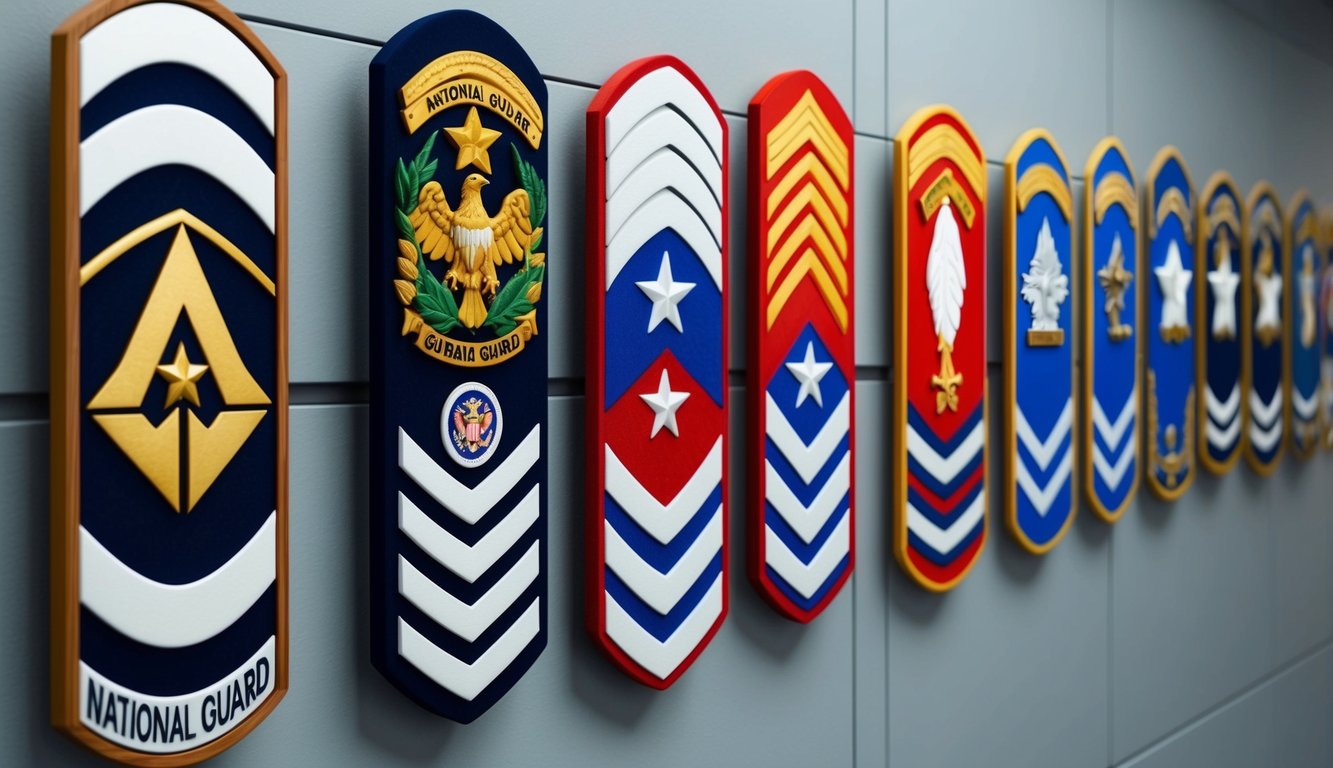
The National Guard maintains a structured ranking system that defines roles, responsibilities, and compensation.
Understanding these ranks clarifies career progression and expectations for Guard members.
How is the rank system organized in the National Guard?
The National Guard adheres to a defined ranking structure similar to that of the U.S. Army.
Ranks are categorized into enlisted, warrant officer, and commissioned officer designations.
Enlisted ranks begin at E-1 (Private) and extend to E-9 (Sergeant Major).
Meanwhile, warrant officers range from W-1 to W-5, and commissioned officers advance from O-1 (Second Lieutenant) to O-10 (General).
What distinguishes enlisted and officer ranks in the National Guard?
Enlisted personnel typically join the National Guard without a college degree, focusing on specialized skills and tactical operations.
Conversely, officers usually hold a bachelor’s degree and are tasked with leadership, strategic planning, and management roles, making critical decisions and overseeing various unit sizes.
Can you outline the ranks in the National Guard from lowest to highest?
Enlisted ranks:
- Private (E-1)
- Private (E-2)
- Private First Class (E-3)
- Specialist/Corporal (E-4)
- Sergeant (E-5)
- Staff Sergeant (E-6)
- Sergeant First Class (E-7)
- Master Sergeant/First Sergeant (E-8)
- Sergeant Major (E-9)
Warrant Officer ranks:
- Warrant Officer 1 (WO1)
- Chief Warrant Officer 2-5 (CW2-CW5)
Commissioned Officer ranks:
- Second Lieutenant (O-1)
- First Lieutenant (O-2)
- Captain (O-3)
- Major (O-4)
- Lieutenant Colonel (O-5)
- Colonel (O-6)
- Brigadier General (O-7)
- Major General (O-8)
- Lieutenant General (O-9)
- General (O-10)
What does the E-4 rank represent in the National Guard?
An E-4 rank within the National Guard can be either a Specialist or a Corporal.
Specialists act as technical experts in their domain without leadership duties.
Corporals, although at the same pay level, are junior non-commissioned officers and may supervise small teams.
What is the highest rank achievable in the National Guard?
The utmost rank in the National Guard is General (O-10).
This four-star general position is exceptionally rare, typically reserved for the Chief of the National Guard Bureau.
Most National Guard members reach lower officer ranks or top enlisted positions like Command Sergeant Major or Sergeant Major.
How does National Guard compensation differ among ranks?
Compensation within the National Guard increases as ranks and years of service rise.
Higher ranks are associated with elevated base pay rates.
Pay can also vary based on duty status, with different remuneration for drill weekends, annual training, and active duty periods.
Additional allowances and benefits may be applicable depending on rank and specific responsibilities.
“`

